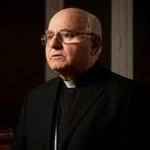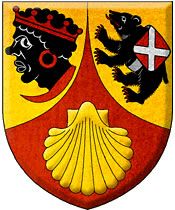 You know Salvatore Cordileone’s name –he’s the new archbishop of San Francsico. A high profile appointment made several weeks ago by Pope Benedict XVI. He was arrested for a DUI charge on August 25. He’s admitted wrong-doing, spent 11 hours in jail, paid the bail and is due in court on October 9, just 5 days following his scheduled installation in SF.
You know Salvatore Cordileone’s name –he’s the new archbishop of San Francsico. A high profile appointment made several weeks ago by Pope Benedict XVI. He was arrested for a DUI charge on August 25. He’s admitted wrong-doing, spent 11 hours in jail, paid the bail and is due in court on October 9, just 5 days following his scheduled installation in SF.
Month: August 2012
Saint Augustine
LET me speak of
another celebrated conquest of God’s grace in an after age, and you will see
how it pleases Him to make a Confessor, a Saint, Doctor of His Church, out of
sin and heresy both together. It was not enough that the Father of the Western
Schools, the author of a thousand works, the triumphant controversialist, the
especial champion of grace, should have been once a poor slave of the flesh,
but he was the victim of a perverted intellect also. He who, of all others, was
to extol the grace of God, was left more than others to experience the
helplessness of nature. The great St Augustine (I am not speaking of the holy
missionary of the same name, who came to England and converted our pagan
forefathers, and became the first Archbishop of Canterbury, but of the great
African Bishop, two centuries before him)–Augustine, I say, not being in
earnest about his soul, not asking himself the question, how was sin to be
washed away, but rather being desirous, while youth and strength lasted, to
enjoy the flesh and the world, ambitious and sensual, judged of truth and
falsehood by his private judgment and his private fancy; despised the Catholic
Church because it spoke so much of faith and subjection, thought to make his
own reason the measure of all things, and accordingly joined a far-spread sect,
which affected to be philosophical and enlightened, to take large views of
things, and to correct the vulgar, that is, the Catholic notions of God and
Christ, of sin, and of the way to heaven. In this sect of his he remained for
some years; yet what he was taught there did not satisfy him. It pleased him
for a time, and then he found he had been eating for food what had no
nourishment in it; he became hungry and thirsty after something more
substantial, he knew not what; he despised himself for being a slave to the
flesh, and he found his religion did not help him to overcome it; thus he
understood that he had not gained the truth, and he cried out, “Oh, who
will tell me where to seek it, and who will bring me into it?”
Residences of Maronite and Melkite Bishops in Aleppo, Syria
Archbishops Youssef Anis Abi-Aad, 72, and Jean-Clément Jeanbart, 69, have taken refuge in other places since their residences were ransacked in the past few days. Clashes between Assad’s forces and other groups are to blame. It is said that “unidentified groups, who want to foster a sectarian war and involve the Syrian people in a sectarian strife.” Not a much more is known at this point.
Luigi Giusanni had gift for deciphering signs of the times, Ignacio Carbajosa Pérez tells Rimini
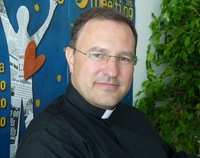 We continually need to get to the heart of who our influences are as people. That is true of Father Luigi Giussani who is being spoken of not only as the founder of the ecclesial movement of Communion and Liberation but also because his cause for canonization is now being studied. Father Ignacio Carbajosa Pérez, 45, said of Father Luigi
We continually need to get to the heart of who our influences are as people. That is true of Father Luigi Giussani who is being spoken of not only as the founder of the ecclesial movement of Communion and Liberation but also because his cause for canonization is now being studied. Father Ignacio Carbajosa Pérez, 45, said of Father Luigi
Giussani, “For me the most striking thing was to hear this man with this love
for my humanity, finally, to find someone who knew very well what is my
humanity and then looked upon it in a sympathetic way.” (Read more of what Father Ignacio told David Kerr here at The Rimini Meeting 2012.)
Rimini Meeting 2012
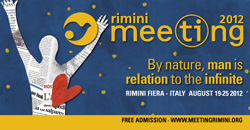 THE most significant cultural and religious meeting in the world is held in the late August: “Rimini Meeting” in the seaside town of Rimini (Italy). From 19-25 August, The Meeting coordinated by members of Communion and Liberation attracts numerous speakers and more than 800K.
THE most significant cultural and religious meeting in the world is held in the late August: “Rimini Meeting” in the seaside town of Rimini (Italy). From 19-25 August, The Meeting coordinated by members of Communion and Liberation attracts numerous speakers and more than 800K.
Pope Benedict writes to The Meeting 2012
The Holy Father, Pope Benedict closely follows The Meeting. He was in attendance several years ago, as was John Paul II in 1982. Picking up from Father Luigi Giussani’s thinking of “life as a vocation”, the Pope reminds us that everything is answered in relationship to the Infinite. On July 11, 2012 I posted a piece called “The Vocation to Life” which is essential reading if you want to know more of what the Pope, Giussani and Christianity is all about.
The Pope’s letter for the 2012 Meeting follows (emphasis mine).
To the Venerable
Brother Monsignor Francesco Lambiasi,
I wish to extend my
cordial greetings to you, to the organizers and to all the participants in the
Meeting for Friendship among Peoples, now in its XXXIII year. The theme chosen
this year – “The nature of man is a relationship with the infinite” – is
particularly significant in view of the approaching start of the Year of Faith,
which I have willed to proclaim to mark the 50th anniversary of the opening of
the Second Vatican Ecumenical Council.
To speak of man and of his yearning for
the infinite means, first and foremost, to recognize his constitutive
relationship with the Creator. Man is a creature of God. Today this word –
creature – seems almost passé: we prefer to think of man as a self-fulfilled
being and master of his own destiny. The consideration of man as a creature
seems “uncomfortable,” because it implies an essential reference to something
else, or better, to Someone else – whom man cannot control – who enters in
order to define his identity in an essential way; a relational identity, whose
first element is the original and ontological dependence on He who wanted us
and created us. Yet this dependence, from which modern and contemporary man
attempts to break free, not only does not hide or diminish, but luminously
reveals the greatness and supreme dignity of man, who is called into life in
order to enter into relationship with Life itself, with God.
Saint Monica
 Everyone ought to have a “Saint Monica” figure in their lives. The sainted mother of Saint Augustine is the patron of spiritual maternity. Even though Monica was the biological mother of Augustine, she worked hard in the spiritual realm to get her son to give himself to Christ and his plan rather than his own plan of self-destructive behavior. Her constant prayer, fasting and good works all contributed to Augustine’s conversion. The collect for today’s Mass speaks volumes.
Everyone ought to have a “Saint Monica” figure in their lives. The sainted mother of Saint Augustine is the patron of spiritual maternity. Even though Monica was the biological mother of Augustine, she worked hard in the spiritual realm to get her son to give himself to Christ and his plan rather than his own plan of self-destructive behavior. Her constant prayer, fasting and good works all contributed to Augustine’s conversion. The collect for today’s Mass speaks volumes.
Pope John Paul I, elected 34 years ago today
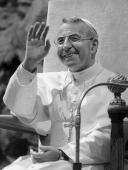 Today is the 34th anniversary of papal election of Albino Luciani as Pope John Paul I. He’s remembered for being the smiling pope and the pope who reigned for 33 days. In some way, Divine Providence gave us this gift and then opened the door for yet another. John Paul’s cause for canonization is being studied.
Today is the 34th anniversary of papal election of Albino Luciani as Pope John Paul I. He’s remembered for being the smiling pope and the pope who reigned for 33 days. In some way, Divine Providence gave us this gift and then opened the door for yet another. John Paul’s cause for canonization is being studied.
Latria ought to be paid to the Eucharist
Among a certain crowd of priests, religious and laity
you will hear that Adoration and Benediction of the Blessed Sacrament is no
longer an appropriate method of prayer: “Vatican II changed all that…” or
they’ll say “That’s ol’time religion.” One priest even told me that Adoration of the Blessed Sacrament is cookie worship. Really? Giving praise to God is
outdated? Adoration of the Holy Name is no longer in vogue? The God who created
you is not worship and made known? None of this reflects my Catholic faith!
I am somewhat certain that those who claim Adoration and Benediction of the Blessed Sacrament neither know the Commandments (to worship God), the Tradition of the Church, the documents of the Second Vatican Council nor the post Conciliar work of Popes Paul, John Paul and Benedict. It is safe to say that these people who reject the the practice of a Holy Hour are the same who who haven’t had a good formation in the faith or the Lex Orandi tradition.
Perhaps we all should recall what the Servant of God Pope Paul VI said in Mysterium
Fidei,
The Catholic Church has always displayed and still
displays this latria that ought to be paid to the Sacrament of the Eucharist,
both during Mass and outside of it, by taking the greatest possible care of
consecrated Hosts, by exposing them to the solemn veneration of the faithful,
and by carrying them about in processions to the joy of great numbers of the
people (56).
‘American dream’ fulfilled in Jesus
As point of clarification, CL is not a “lay ecclesial movement”; it is technically improper to call the ecclesial movements “lay ecclesial movements” because the movements are not limited to the lay faithful, but are open to the ordained as well. Many of the movements have ardent followers who are deacons, priests and bishops in the movements. Therefore, not “lay ecclesial.”


